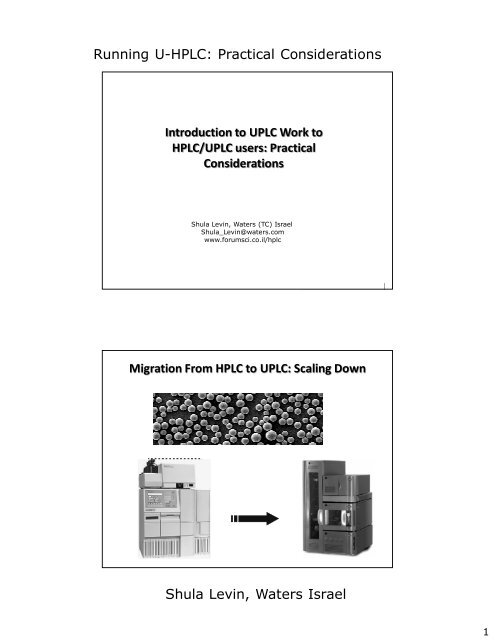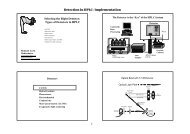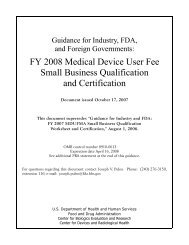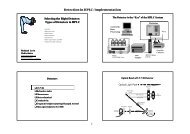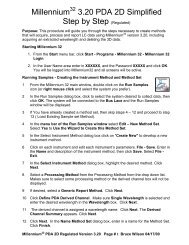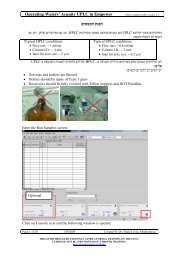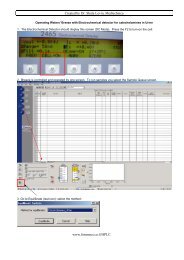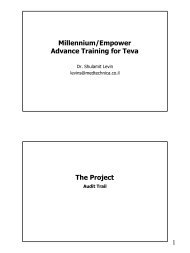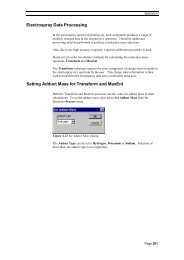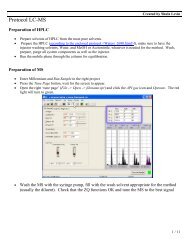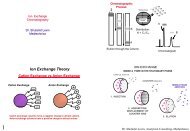3 - UPLC_Work_Practical_Considerations
3 - UPLC_Work_Practical_Considerations
3 - UPLC_Work_Practical_Considerations
Create successful ePaper yourself
Turn your PDF publications into a flip-book with our unique Google optimized e-Paper software.
Running U-HPLC: <strong>Practical</strong> <strong>Considerations</strong><br />
Introduction to <strong>UPLC</strong> <strong>Work</strong> to<br />
HPLC/<strong>UPLC</strong> users: <strong>Practical</strong><br />
<strong>Considerations</strong><br />
Shula Levin, Waters (TC) Israel<br />
Shula_Levin@waters.com<br />
www.forumsci.co.il/hplc<br />
Migration From HPLC to <strong>UPLC</strong>: Scaling Down<br />
Shula Levin, Waters Israel<br />
1
Running U-HPLC: <strong>Practical</strong> <strong>Considerations</strong><br />
The practice of <strong>UPLC</strong> operation is the same whether it is a Binary or a<br />
Quaternary System<br />
Solvent Management<br />
ACQUITY <strong>UPLC</strong> ACQUITY <strong>UPLC</strong> H-Class<br />
Solvent Manager Design Binary - 2 solvents Quaternary - 4 solvents<br />
Total Number of Solvents Solvents A1 or A2 and B1 or B2<br />
Solvents A, B, C, D<br />
(Solvents D 1-6 via SSV option)<br />
Type of Solvent Mixing High pressure mixing Low pressure mixing<br />
System Volume < 100uL standard configuration < 400uL standard configuration<br />
Column I.D. 1.0 mm to 4.6 mm 2.1 mm to 4.6 mm<br />
Pressure/Flow Performance<br />
15,000 psi up to 1mL/min<br />
9,000 psi up to 2mL/min<br />
Flow Rate Range 0.01 to 2mL/min<br />
Shula Levin, Waters Israel<br />
2
Running U-HPLC: <strong>Practical</strong> <strong>Considerations</strong><br />
Peaks are narrower in <strong>UPLC</strong>!<br />
Higher Sensitivity<br />
Separation between closely<br />
related compounds<br />
Higher peak capacity<br />
Shorter run times<br />
HPLC<br />
Typical Peak Width: 10-60 sec<br />
Solvents and cost saving<br />
<strong>UPLC</strong><br />
Typical Peak Width: 2-10 sec<br />
Technology Changes from HPLC to <strong>UPLC</strong><br />
Detector’s Optics<br />
& Fast Electronics<br />
Minimum Volume of Flow Cell<br />
a Mobile Phase<br />
TeflonAF<br />
TeflonAF<br />
Injector’s Low Volumes<br />
Power Switch<br />
LEDs<br />
Solvent Select Valves<br />
Seal Wash<br />
Independent drives for A1, A2, B1, B2<br />
Vent Filter/ Mixer/<br />
Valve Tee Assembly<br />
Shula Levin, Waters Israel<br />
Six<br />
cha<br />
nne<br />
l<br />
deg<br />
ass<br />
er<br />
Leak<br />
Detector<br />
High Pressure Pump<br />
With Low Delay volume<br />
High Speed Gradients<br />
Column-Over: Minimum Extra<br />
Column Band Broadening<br />
Strong & Smooth Tubings<br />
& connections<br />
OH OH OH OH OH H2 C CH 2<br />
OH OH<br />
Si Si Si Si Si Si Si Si Si<br />
O O O O O O O O O O<br />
O O O O O O O<br />
Si<br />
O<br />
O<br />
Si<br />
O<br />
H2 C<br />
CH2<br />
CH<br />
2 O<br />
H<br />
2<br />
C<br />
Si Si Si Si Si Si Si Si Si<br />
O O O O O O O O O<br />
H<br />
2<br />
C CH<br />
2 O O O O O O O O<br />
Column Packing Enduring high<br />
pressures & Temperatures<br />
OH<br />
3
Running U-HPLC: <strong>Practical</strong> <strong>Considerations</strong><br />
םג<br />
ןכו<br />
, HPLC<br />
Running <strong>UPLC</strong><br />
תונולוקב רשאמ הברהב םינטק םה <strong>UPLC</strong> תנולוק ךותב םיקיקלחה<br />
. ןהלש םירטליפה<br />
Typical HPLC conditions:<br />
Flow rate: ~ 1 ml/mn<br />
Column I.D.: ~ 4 mm<br />
Inlet frit pore size: ~ 2 μ m<br />
Typical <strong>UPLC</strong> conditions:<br />
Flow rate: ~ 0.6 ml/mn<br />
Column I.D.: ~ 2 mm<br />
Inlet frit pore size: ~ 0.2 μ m<br />
<strong>UPLC</strong> ב תפטושה הדובעל עירפהל םילולע HPLC -ב<br />
הדובעל תידיימ םיעירפמ אלש םינטק םיקיקלח ןכל<br />
Preparing to Run<br />
Preparing a Dry Instrument<br />
Strong and Weak Wash Solvents<br />
System and Loop Volume<br />
Determination<br />
Instrument Method Parameters<br />
Shula Levin, Waters Israel<br />
4
Running U-HPLC: <strong>Practical</strong> <strong>Considerations</strong><br />
General Operating Practices<br />
• Prepare fresh solvents daily. Do NOT top-up aqueous<br />
solvents – use a fresh reservoir bottle. Bacterial<br />
contamination is a real problem.<br />
• Make up only 500 mL at a time.<br />
• Water obtained from a properly-maintained Milli-Q ®<br />
system does not need to be re-filtered unless buffer<br />
salts are added. Preferably: use a recognized <strong>UPLC</strong> or<br />
LC-MS grade solvent.<br />
• HPLC-Grade ACN or MeOH that has already been<br />
filtered (certified on the bottle) does not need to be<br />
re-filtered. Preferably: Use a recognized <strong>UPLC</strong> or LC-<br />
MS grade solvent<br />
General Operating Practices<br />
• Make sure to cover bottles to protect it from dust!<br />
• Do NOT use Parafilm ® to cover bottles – it dissolves.<br />
•Old solvents and buffers are filtered<br />
•Reservoirs should be fully covered with Teflon stoppers and NOT Parafilm<br />
•Use filters to block dust from the air (Photo)<br />
•Bottles should be made of Type 1 glass<br />
Shula Levin, Waters Israel<br />
5
Running U-HPLC: <strong>Practical</strong> <strong>Considerations</strong><br />
General Operating<br />
Recommendations<br />
• Use only Pyrex (Borosilicate 3.3) bottles. DURAN bottles<br />
dissolve at high pH (>9).<br />
• Use highest quality solvents, water, buffers and additives.<br />
• Flush buffers out of system with water after use (use 10-<br />
20% organic in water for storage).<br />
• Keep all 4 solvent lines primed (use 10-20% organic in<br />
water for unused lines).<br />
• Keep seal wash primed.<br />
• Re-prime solvent lines before starting.<br />
• Use 100 µL mixer for TFA/ACN gradients at low<br />
wavelengths.<br />
CORNING PYREX ® Type 1, Class A, Borosilicate Bottles<br />
SCHOTT DURAN ® Borosilicate Glass 3.3 Bottles<br />
Also: if Biolab solvents: Use ULC/MS grade only!<br />
Shula Levin, Waters Israel<br />
6
Running U-HPLC: <strong>Practical</strong> <strong>Considerations</strong><br />
Solvent Filters<br />
Critical Clean<br />
Stainless Steel (7 pack)700003616<br />
Stainless Steel (1/pk) 700003615<br />
Titanium (7 pack) 700003530<br />
Titanium (1 pack) 700003546<br />
Mobile Phase Preparation<br />
Filtration on membrane:<br />
Actions : Solvent degassing and filtration<br />
— Potential of impurities in filtration<br />
o GHP, PTFE, Nylon, or PVDF<br />
— Pores diameter : 0.2 µm.<br />
— Volatile additives may evaporate.<br />
NOTE: Refer to ‘Controlling Contamination in<br />
UltraPerformance LC/MS and HPLC Systems’<br />
715001307D available from Waters Corp.<br />
Solvent filter assembly 289002172<br />
Solvent filter insert 5 µm 700002756<br />
PAT (PEEK Alloyed with Teflon) filter<br />
PSL901292 2 µm<br />
PSL901294 5 µm<br />
Shula Levin, Waters Israel<br />
7
Running U-HPLC: <strong>Practical</strong> <strong>Considerations</strong><br />
Bottle Caps<br />
WAT062341 4 L bottle (large neck)<br />
WAT062479 1 L bottle (small neck)<br />
No Parafilm ® or other plastic films to cover solvent reservoirs<br />
Transferring Methods from HPLC to <strong>UPLC</strong><br />
and from Binary to Quaternary <strong>UPLC</strong><br />
Shula Levin, Waters Israel<br />
8
Running U-HPLC: <strong>Practical</strong> <strong>Considerations</strong><br />
Method Transfer Tools<br />
• New Columns Calculator<br />
– Now from HPLC to <strong>UPLC</strong> to HPLC<br />
– Localized<br />
– Ability to cut and paste conditions<br />
into Empower Methods Editor<br />
• Pre-injection volume and Gradient<br />
Smart Start<br />
– Useful for accommodating systems<br />
with different dwell volumes<br />
• New Method Transfer Chemistry Kits<br />
Transferring HPLC Methods between HPLC<br />
Systems of Multiple Vendors<br />
• Differences in system volume<br />
– keep the column/system volume ratio constant to ensure a similar ‘isocratic hold’ caused<br />
by the system at the beginning of the gradient.<br />
• An isocratic hold can be added to the gradient table if the system volume of the new<br />
HPLC is smaller<br />
• An injection hold may be added if the system volume of the new HPLC is larger<br />
(setting the pre-column volume to non-zero in the instrument method)<br />
• Differences in column heating<br />
– Column heaters have different heating efficiencies and the differences can impact<br />
absolute retention of the components and selectivity<br />
Shula Levin, Waters Israel<br />
9
Running U-HPLC: <strong>Practical</strong> <strong>Considerations</strong><br />
Transferring HPLC Methods between HPLC<br />
Systems of Multiple Vendors<br />
Transfer Methods With Ease<br />
Utilize existing Assets<br />
Transfer from<br />
<strong>UPLC</strong>-to-HPLC<br />
Original HPLC System<br />
Vendor A HPLC System<br />
Vendor B HPLC System<br />
ACQUITY <strong>UPLC</strong> System<br />
ACQUITY H Class System<br />
Future-proof your lab<br />
Run HPLC methods on<br />
ACQUITY <strong>UPLC</strong> H-Class<br />
Shula Levin, Waters Israel<br />
10
Running U-HPLC: <strong>Practical</strong> <strong>Considerations</strong><br />
AU<br />
AU<br />
Transfer between Binary to Quaternary <strong>UPLC</strong><br />
2.00<br />
1.80<br />
1.60<br />
1.40<br />
1.20<br />
1.00<br />
0.80<br />
0.60<br />
0.40<br />
0.20<br />
0.00<br />
Peak1 - 1.937<br />
Peak2 - 2.301<br />
Auto-Scaled Chromatogram<br />
Peak3 - 5.074<br />
Peak4 - 5.308<br />
0.00 1.00 2.00 3.00 4.00 5.00 6.00 7.00 8.00 9.00 10.00<br />
Minutes<br />
System Name <strong>UPLC</strong>02; SampleName SST test 2; Acq Method Set DMAD12; Date<br />
Acquired 11/03/2010 09:57:18 IST; Channel Description ACQUITY TUV ChA 254nm<br />
2.20<br />
2.00<br />
1.80<br />
1.60<br />
1.40<br />
1.20<br />
1.00<br />
0.80<br />
0.60<br />
0.40<br />
0.20<br />
0.00<br />
Peak1 - 2.107<br />
Peak2 - 2.362<br />
Peak5 - 5.997<br />
Auto-Scaled Chromatogram<br />
3.865<br />
-0.20<br />
0.00 1.00 2.00 3.00 4.00 5.00<br />
Minutes<br />
6.00 7.00 8.00 9.00 10.00<br />
System Name H CLASS; SampleName SST PZP passive therm 400 ul-del; Acq<br />
Method Set Tevatest2_passive_Therm_del400; Date Acquired 13/06/2010 12:24:39<br />
IDT; Channel Description PDA Ch1 254nm@4.8nm<br />
Peak3 - 5.126<br />
Peak4 - 5.361<br />
5.668<br />
Peak5 - 5.970<br />
Peak6 - 6.132<br />
Differences in System Volume:<br />
Low vs. High Pressure Mixing<br />
Acquity <strong>UPLC</strong> (Binary-Mixing)<br />
Smaller System Volume = Smaller Dwell volume (~120 mL)<br />
A B C<br />
D<br />
Gradient<br />
Proportioning<br />
Valve<br />
Pump A<br />
Pump B<br />
Mixer<br />
Injector<br />
Shula Levin, Waters Israel<br />
6.640<br />
Column<br />
Detector<br />
H-Class <strong>UPLC</strong> (Quaternary-Mixing)<br />
Larger System Volume = Larger Dwell volume (~400 mL)<br />
Pump<br />
Injector<br />
Column<br />
Detector<br />
11
Running U-HPLC: <strong>Practical</strong> <strong>Considerations</strong><br />
Solvent Composition<br />
at Mixer<br />
Solvent Composition<br />
at Column Head<br />
System Delay (Dwell) Volume<br />
Timing Offset<br />
0<br />
Injection<br />
Actual mobile phase<br />
profile on original<br />
system measured at<br />
the column inlet<br />
System volume creates an offset before the solvent<br />
composition change reaches the inlet of column (i.e. an<br />
“isocratic hold” at the beginning of every gradient)<br />
Smaller Volume<br />
System Volume 0.35 mL<br />
{<br />
}<br />
Target System with smaller volume<br />
(less isocratic hold time)<br />
t g<br />
Shula Levin, Waters Israel<br />
x<br />
Time<br />
Different System Volumes<br />
Effect on Separation<br />
Original<br />
Instrument<br />
System Volume 0.0.7 mL<br />
Larger Volume<br />
System Volume 1.4 mL<br />
Target System with larger volume<br />
(longer isocratic hold time)<br />
12
Running U-HPLC: <strong>Practical</strong> <strong>Considerations</strong><br />
<strong>Considerations</strong> in Method Development<br />
ACQUITY <strong>UPLC</strong> ® H-Class:<br />
Options for Method Development<br />
• Column Managers can be “banked” to<br />
support up to 6 columns<br />
• CM-A target is mid 2Q10<br />
• Can have CM-A + CH-A<br />
• Flow through needle injector<br />
• Quaternary multi solvent mixing<br />
• D line solvents 1-6 using internal solvent<br />
selection valve<br />
• SSV target is end 1Q10<br />
Shula Levin, Waters Israel<br />
13
Running U-HPLC: <strong>Practical</strong> <strong>Considerations</strong><br />
Automated Method Development<br />
LAN<br />
LAC/E Card<br />
Network<br />
4-Relay<br />
Panel<br />
Shula Levin, Waters Israel<br />
Solvent Valve Assembly<br />
ACQUITY <strong>UPLC</strong> H-Class<br />
Target is end 1Q10<br />
Auto•Blend: Constitute the Mobile Phase on<br />
the Fly.<br />
Water Acetonitrile<br />
Alcohol Concentrated<br />
Modifier<br />
14
Running U-HPLC: <strong>Practical</strong> <strong>Considerations</strong><br />
95%<br />
Water<br />
0%<br />
Isopropanol<br />
100% Water<br />
0% Acetonitrile<br />
0.05% TFA<br />
AU<br />
AU<br />
AU<br />
0.15<br />
0.10<br />
0.05<br />
0.00<br />
0.25<br />
0.20<br />
0.15<br />
0.10<br />
0.20<br />
0.15<br />
0.10<br />
0.05<br />
Auto•Blend Gradient<br />
0%<br />
Acetonitrile Water<br />
5%<br />
1%TFA<br />
45%<br />
0%<br />
Isopropanol<br />
50%<br />
Acetonitrile<br />
5%<br />
1%TFA<br />
Peptide Map Development<br />
Varying TFA Concentration - %D<br />
Shula Levin, Waters Israel<br />
50% Water<br />
50% Acetonitrile<br />
0.05% TFA<br />
0.025% TFA – 2.5% D<br />
0.05% TFA – 5% D<br />
0.1% TFA – 10% D<br />
27.00 27.50 28.00 28.50 29.00 29.50 30.00 30.50 31.00 31.50 32.00 32.50 33.00 33.50 34.00 34.50 35.00 35.50 36.00 36.50 37.00<br />
Minutes<br />
15
Running U-HPLC: <strong>Practical</strong> <strong>Considerations</strong><br />
AU<br />
AU<br />
AU<br />
AU<br />
AU<br />
AU<br />
AU<br />
0.10<br />
0.05<br />
0.10<br />
0.05<br />
0.10<br />
0.05<br />
0.10<br />
0.05<br />
0.10<br />
0.05<br />
0.10<br />
0.05<br />
0.10<br />
0.05<br />
Stability and Reproducibility<br />
Peptide Mapping<br />
8.00 10.00 12.00 14.00 16.00 18.00 20.00 22.00 24.00 26.00 28.00 30.00 32.00 34.00 36.00 38.00 40.00 42.00 44.00 46.00 48.00 50.00 52.00 54.00<br />
Minutes<br />
ACQUITY <strong>UPLC</strong> H-Class<br />
Sample Manager -FTN<br />
• Programmable Volume Injection<br />
– Up to 10uL injection standard<br />
– Up to 250uL with extensions<br />
• Needle in flow path design<br />
– Total volume sample injection<br />
– Low carryover performance<br />
• Full range of plates and vials<br />
• Supports load ahead and loop offline<br />
Shula Levin, Waters Israel<br />
Friday Night<br />
Saturday Morning<br />
Saturday Afternoon<br />
Saturday Night<br />
Sunday Morning<br />
Sunday Afternoon<br />
Sunday Night<br />
16
Running U-HPLC: <strong>Practical</strong> <strong>Considerations</strong><br />
SM-FTN Characteristics<br />
• Needle in flow path design<br />
– Injection volumes up to 250uL (with additional needles and/or extension loops)<br />
– Needle flushed with the entire separation gradient<br />
• Low carryover performance<br />
• Supports load ahead and loop offline<br />
ACQUITY <strong>UPLC</strong> H-Class<br />
Sample Manager -FTN<br />
Shula Levin, Waters Israel<br />
17
Running U-HPLC: <strong>Practical</strong> <strong>Considerations</strong><br />
Sample Manager –FTN<br />
Sample Loading<br />
Sample Manager –FTN<br />
Sample Injection<br />
Shula Levin, Waters Israel<br />
18
Running U-HPLC: <strong>Practical</strong> <strong>Considerations</strong><br />
Injection Performance<br />
2 Orders of Magnitude<br />
No re-configuration necessary across the entire <strong>UPLC</strong> injection volume range<br />
Area<br />
Area<br />
Area<br />
300000<br />
200000<br />
100000<br />
10.0µL @ 2µg/mL<br />
1.0µL @ 20µg/mL<br />
0.1µL @ 200µg/mL<br />
Same peak area<br />
Linearity Test: Injection Volumes<br />
0<br />
Calibration Plot<br />
0.00 2.00 4.00 6.00 8.00 10.00 12.00<br />
Injection Volume uL<br />
Name: acetanilide; Fit Type: Linear (1st<br />
Order); Equation Y = 2.66e+004 X -<br />
8.70e+002; R^2 0.999997<br />
50000.0<br />
40000.0<br />
30000.0<br />
20000.0<br />
10000.0<br />
0.0<br />
Calibration Plot<br />
0.00 2.00 4.00 6.00 8.00 10.00 12.00<br />
Injection Volume uL<br />
Name: propiophenone; Fit Type: Linear<br />
(1st Order); Equation Y = 3.47e+003 X -<br />
1.09e+002; R^2 0.999996<br />
250000<br />
200000<br />
150000<br />
100000<br />
50000<br />
0<br />
Calibration Plot<br />
0.00 2.00 4.00 6.00 8.00 10.00 12.00<br />
Injection Volume uL<br />
Name: benzophenone; Fit Type: Linear<br />
(1st Order); Equation Y = 1.85e+004 X -<br />
5.74e+002; R^2 0.999993<br />
Area<br />
Area<br />
Area<br />
100000.0<br />
80000.0<br />
60000.0<br />
40000.0<br />
20000.0<br />
0.0<br />
Calibration Plot<br />
0.00 5.00 10.00<br />
Injection Volume uL<br />
Name: acetophenone; Fit Type: Linear<br />
(1st Order); Equation Y = 7.40e+003 X -<br />
2.47e+002; R^2 0.999998<br />
250000<br />
200000<br />
150000<br />
100000<br />
50000<br />
0<br />
Calibration Plot<br />
0.00 2.00 4.00 6.00 8.00 10.00 12.00<br />
Injection Volume uL<br />
Name: butylparaben; Fit Type: Linear (1st<br />
Order); Equation Y = 1.87e+004 X -<br />
6.19e+002; R^2 0.999991<br />
20000.0<br />
15000.0<br />
10000.0<br />
5000.0<br />
0.0<br />
Calibration Plot<br />
0.00 2.00 4.00 6.00 8.00 10.00 12.00<br />
Injection Volume uL<br />
Name: valerophenone; Fit Type: Linear<br />
(1st Order); Equation Y = 1.44e+003 X -<br />
1.29e+000; R^2 0.999964<br />
Shula Levin, Waters Israel<br />
19
Running U-HPLC: <strong>Practical</strong> <strong>Considerations</strong><br />
Sample Manager –FTN<br />
Carryover Challenge<br />
Shula Levin, Waters Israel<br />
3.5 AU Full Scale<br />
3.5 AU<br />
Full Scale<br />
Stress Injection @ 2mg/mL<br />
1st Blank Injection<br />
Carryover = 0.0002%<br />
Managing Column Temperature<br />
• Temperature affects separation selectivity,<br />
retention and resolution<br />
• Incoming solvent at room temperature<br />
• Passively heated in “Air Bath”<br />
• Transit time is 15-20 seconds<br />
• Temperature gradients from inlet to outlet and<br />
wall to center<br />
• Pre-heating solvent absolutely necessary for<br />
separation control, reproducibility, and transfer<br />
20
Running U-HPLC: <strong>Practical</strong> <strong>Considerations</strong><br />
ACQUITY <strong>UPLC</strong> H-Class<br />
Active Pre-heating<br />
• Ensures consistent control of temperature<br />
• Eliminates environmental influences on<br />
temperature<br />
• Reduced volume to reduce extra column<br />
bandspreading<br />
• Passive pre-heaters supported for backwards<br />
compatibility<br />
Injection Parameters in Fixed Loop<br />
Autosamplers<br />
Shula Levin, Waters Israel<br />
21
Running U-HPLC: <strong>Practical</strong> <strong>Considerations</strong><br />
Injector design examples<br />
Flow-Through variable injector design<br />
0.040<br />
0.030<br />
0.020<br />
AU<br />
0.010<br />
0.000<br />
-0.010<br />
loop<br />
Alliance 2695 and H-Class <strong>UPLC</strong><br />
Mounting of the loop<br />
MUST BE PROPER!!<br />
5.605.705.805.906.006.106.206.306.40<br />
Minutes<br />
Typical problem with bad peek<br />
connections<br />
First blank 0.1 %<br />
Second blank 0.01 %.<br />
.<br />
ACQUITY fixed loop injector design<br />
(Rheodyne)<br />
Shula Levin, Waters Israel<br />
loop<br />
With proper Peek<br />
connections<br />
First blank
Running U-HPLC: <strong>Practical</strong> <strong>Considerations</strong><br />
ACQUITY <strong>UPLC</strong> Sample Manager<br />
Injection Methods<br />
THREE injection methods available:<br />
1. Full Loop Injection Method/Mode as the injection technique using “Pressure Assist”<br />
• Injects 100% of actual loop volume<br />
2. Partial Loop Injection Method/Mode using “Needle Overfill” as the injection technique<br />
• Selectable: Recommended from 10% to 75% of total loop volume<br />
3. Partial Loop Injection Method/Mode using “Pressure Assist” as the injection technique<br />
• Selectable: Recommended from 10% to 50% of total loop volume<br />
Recommendations for ACQUITY <strong>UPLC</strong><br />
Sample Manager Injection Methods<br />
Shula Levin, Waters Israel<br />
23
Running U-HPLC: <strong>Practical</strong> <strong>Considerations</strong><br />
needle<br />
VDD<br />
Sample Syringe<br />
Wash cycle after injection<br />
BSM<br />
to column and<br />
detector<br />
loop<br />
Possible contaminated area<br />
Wash block<br />
VDD<br />
Sample Syringe<br />
BSM<br />
loop<br />
Strong needle wash followed<br />
by weak needle wash<br />
Wash Solvent description<br />
• There are two wash solvents<br />
– Strong Needle Wash<br />
• Tubing flushing<br />
• Elimination of components injected<br />
• Never injected<br />
– Weak Needle Wash<br />
• Strong solvent elimination<br />
• Injected with the sample in partial loop pressure assist mode<br />
Shula Levin, Waters Israel<br />
to column and<br />
detector<br />
24
Running U-HPLC: <strong>Practical</strong> <strong>Considerations</strong><br />
Wash Solvent <strong>Considerations</strong><br />
• As a general principle, strong and weak solvents should include the<br />
same organic species<br />
– This may not always be practicable, especially in the case of “sticky”<br />
samples. You may, however use a 100% organic strong wash solvent<br />
• Do not use salt buffers in wash solvents<br />
• Wash volume ratio (weak to strong)<br />
– Should be about 3:1, weak wash to strong<br />
– Sufficient to ensure the weak wash flushes the strong from the needle<br />
and sample loop<br />
• For more details on solvents, see the section titled “Selecting weak<br />
wash and strong wash solvents” in the ACQUITY Operators Guide<br />
Strong Wash Solvent<br />
• Flushes internal and external portion of the needle to prevent<br />
carryover<br />
• Typically stronger than sample and mobile phase to dissolve<br />
sample residue<br />
• Function performed in the wash station<br />
• Strong solvent should be no stronger than the concentration<br />
needed to reduce carryover to an acceptable level<br />
• Strong wash solvent does not contact the sample<br />
Shula Levin, Waters Israel<br />
25
Running U-HPLC: <strong>Practical</strong> <strong>Considerations</strong><br />
Strong Wash Solvent<br />
• Choose based on the chemistry application<br />
• 100% organic solvent is acceptable<br />
– Except THF<br />
– Do not add acid or base in 100% organic solvent<br />
• Prime using the needle wash function<br />
• Default value is 200 µL<br />
– 200 µL is a typical value for this function<br />
Weak Wash Solvent<br />
• Purges needle and syringe fluid path<br />
• Must be compatible with sample solvent<br />
• For best results, weak wash solvent should be<br />
equivalent to the following (excluding buffers):<br />
– mobile phase composition (for isocratic separations)<br />
– initial gradient condition (for gradient separations)<br />
– If you dilute the samples, match the weak wash solvent to<br />
the sample diluent<br />
• Degassed for good hydraulic properties<br />
Shula Levin, Waters Israel<br />
26
Running U-HPLC: <strong>Practical</strong> <strong>Considerations</strong><br />
Weak Wash Solvent<br />
• Compatible with initial gradient conditions and<br />
sample solubility<br />
• Avoid buffers<br />
– increases the risks of precipitation at re-<br />
equilibration<br />
• Five prime cycles fully replace wash solvents<br />
• Default value is 200 µL<br />
ACQUITY <strong>UPLC</strong> Sample Manager<br />
Injection Methods<br />
THREE injection methods available:<br />
1. Full Loop Injection Method/Mode as the injection technique using “Pressure Assist”<br />
• Injects 100% of actual loop volume<br />
2. Partial Loop Injection Method/Mode using “Needle Overfill” as the injection technique<br />
• Selectable: Recommended from 10% to 75% of total loop volume<br />
3. Partial Loop Injection Method/Mode using “Pressure Assist” as the injection technique<br />
• Selectable: Recommended from 10% to 50% of total loop volume<br />
Shula Levin, Waters Israel<br />
27
Running U-HPLC: <strong>Practical</strong> <strong>Considerations</strong><br />
Full Loop Injection<br />
Example of a 20 µL injection with a 4X overfill<br />
20 µL Sample<br />
Weak Wash<br />
Solvent<br />
Air Gap<br />
Sample<br />
Sample<br />
Weak Wash<br />
Solvent<br />
Air Gap<br />
30 µL<br />
sample<br />
volume<br />
Sample Loop<br />
Volume Injected<br />
Overfill Factor 1 to 4<br />
30 µL<br />
sample<br />
volume<br />
Full Loop Injection<br />
Step 1 – Aspirate sample and air gap<br />
Shula Levin, Waters Israel<br />
28
Running U-HPLC: <strong>Practical</strong> <strong>Considerations</strong><br />
Full Loop Injection<br />
Step 2 – Pressurize and position sample in valve<br />
Full Loop Injection<br />
Step 3 – Position sample and overfill the loop<br />
Sample Loop contains only sample<br />
No Air Gaps<br />
No weak wash<br />
Shula Levin, Waters Israel<br />
29
Running U-HPLC: <strong>Practical</strong> <strong>Considerations</strong><br />
Full Loop Injection<br />
Step 4 – Sample Injection<br />
Summary of Full Loop injection mode<br />
• Best accuracy and precision performance<br />
• Needs multiple loop volumes of additional<br />
sample to be used per injection<br />
• Larger overfill factors are required for smaller<br />
loops<br />
• Need to change injection loops to vary volume<br />
Shula Levin, Waters Israel<br />
30
Running U-HPLC: <strong>Practical</strong> <strong>Considerations</strong><br />
Summary of Full Loop<br />
Injection Mode<br />
• BENEFITS<br />
– Best accuracy and precision performance<br />
• TRADEOFF<br />
– Needs multiple loop volumes of additional sample<br />
to be used per injection<br />
• larger overfill factors are required for smaller loops<br />
(buffer zone improvement)<br />
– Need to change injection loops to vary volume<br />
Partial Loop Injection<br />
Weak Wash<br />
Solvent<br />
Sample<br />
Air Gap<br />
Sample Loop<br />
Volume Injected<br />
Weak Wash<br />
Solvent<br />
Shula Levin, Waters Israel<br />
31
Running U-HPLC: <strong>Practical</strong> <strong>Considerations</strong><br />
Partial Loop (Pressure Assist)<br />
Loop Volume (µL) Needle Overfill<br />
1 Not Recommended<br />
2 Not Recommended<br />
5 Not Recommended<br />
10 1.0 – 5.0<br />
20 2.0 – 10.0<br />
50 5.0 – 25.0<br />
Pressure Assist Injection Sequence<br />
Step 1 – Aspirate sample and air gap<br />
Shula Levin, Waters Israel<br />
32
Running U-HPLC: <strong>Practical</strong> <strong>Considerations</strong><br />
Pressure Assist Injection Sequence<br />
Step 2 – Pressurize and position sample in valve<br />
Pressure Assist Injection Sequence<br />
Step 3 – Position the sample<br />
Shula Levin, Waters Israel<br />
33
Running U-HPLC: <strong>Practical</strong> <strong>Considerations</strong><br />
Pressure Assist Injection Sequence<br />
Step 4 – Injection valve injects sample<br />
Sample Loop contains<br />
Sample, air gaps and weak wash<br />
Summary of Partial Loop<br />
using Pressure Assist<br />
• Shorter Cycle Time than PLUNO<br />
• No sample cushion<br />
• Sample volume is conserved<br />
• Recommended for large sample loop injections<br />
• Performance dependency on weak wash solvent matching<br />
to mobile phase<br />
• Air Gaps injected onto Column<br />
• Accuracy is generally lower compared to Needle Overfill<br />
• Has lower injection range, within a given loop for partial<br />
loop injections. Injection range is from 10 – 50% of the<br />
loop volume<br />
• Accuracy and Precision are lower than Full Loop Mode<br />
Shula Levin, Waters Israel<br />
34
Running U-HPLC: <strong>Practical</strong> <strong>Considerations</strong><br />
Partial Loop Using Needle Overfill<br />
Summary of Partial Loop<br />
using Pressure Assist<br />
• BENEFITS:<br />
– Short Cycle Time<br />
– Sample volume is conserved<br />
– Recommended for large sample loop injections<br />
• TRADEOFF:<br />
– Accuracy and Precision are lower than Full Loop Mode<br />
– Performance dependency on weak wash solvent matching<br />
to mobile phase<br />
– Accuracy is generally lower compared to Needle Overfill<br />
Shula Levin, Waters Israel<br />
35
Running U-HPLC: <strong>Practical</strong> <strong>Considerations</strong><br />
Partial Loop Using Needle Overfill<br />
Partial Loop using Needle Overfill<br />
Step 1– Aspirate Sample and Air Gap<br />
Shula Levin, Waters Israel<br />
36
Running U-HPLC: <strong>Practical</strong> <strong>Considerations</strong><br />
Partial Loop using Needle Overfill<br />
Step 2 – Injection Sequence<br />
Partial Loop using Needle Overfill<br />
Step 3 – Injection Sequence<br />
Shula Levin, Waters Israel<br />
37
Running U-HPLC: <strong>Practical</strong> <strong>Considerations</strong><br />
Partial Loop using Needle Overfill<br />
Step 4 – Injection Sequence<br />
Partial Loop using Needle Overfill<br />
Step 5 – Injection Sequence<br />
Shula Levin, Waters Israel<br />
38
Running U-HPLC: <strong>Practical</strong> <strong>Considerations</strong><br />
Summary of Partial Loop<br />
using Needle Overfill<br />
• No weak wash injected onto column<br />
– mobile phase and sample injected<br />
• Air gap not injected on column<br />
• Sample does not come into contact with weak wash<br />
• Recommended for partial loop injections, especially from<br />
small loops because accuracy is improved compared to<br />
Pressure Assist Partial loop injections<br />
• Has wider linear range, can inject from 10 – 75% of the loop<br />
volume<br />
• Cycle time depending on aspiration rate (with smaller loops<br />
the time increases)<br />
• Needs 15 µL additional sample to be used for cushion<br />
volume per injection irregardless of injection size<br />
• Accuracy and precision lower than full loop mode<br />
Manual settings<br />
(need to be set)<br />
Injection Parameters<br />
Injection Parameters<br />
Automatic settings<br />
(already set in the software<br />
See HELP)<br />
Shula Levin, Waters Israel<br />
39
Running U-HPLC: <strong>Practical</strong> <strong>Considerations</strong><br />
Injection Air Gap<br />
• Automatic or manual<br />
• Full loop or partial loop injection<br />
– Critical for partial loop injection<br />
Good Repeatability:<br />
Setting Up the Sample Manager<br />
• Full loop<br />
– Air gap<br />
• 4 µL for 30 µL needle<br />
• 2 µL for 15 µL needle<br />
– Overfill factor depends on loop size<br />
• see Help for Automatic parameters<br />
– Metering device compatible with sample volume<br />
• Partial loop<br />
– Low draw speed for low volume<br />
– Pre and post air gap are essential<br />
– Automatic parameters<br />
• Pre and post air gap of 1 µL<br />
• 100 µL per minute<br />
Shula Levin, Waters Israel<br />
40
Running U-HPLC: <strong>Practical</strong> <strong>Considerations</strong><br />
Strong Contaminations<br />
• If the system is contaminated, some spare<br />
parts must be changed<br />
– Why:<br />
• Due to previous bad or not appropriate washing, contamination has been<br />
accumulated and then released since the system is not able to compensate<br />
anymore<br />
• Manual washing is not strong enough to eliminate carry-over<br />
– How: Which spare parts must be changed<br />
• Seal wash of the wash station<br />
• Needle<br />
• VDD (bubble detector)<br />
• Loop<br />
Main Parameters Summary<br />
• Strong Washing<br />
– Strong solvent 200 µL<br />
• Weak Wash<br />
– Weak solvent 600 µL<br />
• Full loop or partial loop injection<br />
– Use automatic settings<br />
• Air gap<br />
– For partial injection<br />
– Automatic<br />
• Draw speed<br />
– Automatic<br />
Shula Levin, Waters Israel<br />
41
Running U-HPLC: <strong>Practical</strong> <strong>Considerations</strong><br />
• Question:<br />
– 1) Should I use air gap?<br />
• Yes or No?<br />
• Which one?<br />
Air Gap<br />
– Pre air, post air or both?<br />
– 2) What volume?<br />
• Question:<br />
– Should I use?<br />
• Full loop<br />
• Partial loop injection<br />
Pre and Post Air Gap Influence: Example<br />
4 4 1 140787 132577 96240 57406 136252 95577 45260 16142<br />
0 0 1 90362 85040 62005 42553 92886 64077 30046 12199<br />
Diffusion effect 55.80% 55.90% 55.21% 34.90% 46.69% 49.16% 50.64% 32.32%<br />
4 4 1 140787 132577 96240 57406 136252 95577 45260 16142<br />
0 4 1 89291 84372 63720 40764 85074 61209 29754 11578<br />
Diffusion effect 57.67% 57.13% 51.04% 40.83% 60.16% 56.15% 52.11% 39.42%<br />
4 4 1 140787 132577 96240 57406 136252 95577 45260 16142<br />
4 0 1 120864 113953 81763 52170 122771 85128 39046 14816<br />
Diffusion effect<br />
16.48% 16.34% 17.71% 10.04% 10.98% 12.27% 15.91% 8.95%<br />
Shula Levin, Waters Israel<br />
42
Running U-HPLC: <strong>Practical</strong> <strong>Considerations</strong><br />
Pre air gap Post air gap Peak area Peak height % area<br />
difference<br />
Automatic<br />
(1)<br />
automatic<br />
Automatic<br />
(1)<br />
Air Gap Effects<br />
pre – air gap is more critical than post – air gap<br />
0,0<br />
38889 27156<br />
4 0 38488 26796 98.97<br />
4 4 38179 26592 98.17<br />
0 4 30866 21404 79.37<br />
0 0 30748 21413 79.07<br />
0,4<br />
Air Gap<br />
• Large air gap volume can effect the<br />
chromatogram.<br />
Shula Levin, Waters Israel<br />
4,4<br />
4,0<br />
43
Running U-HPLC: <strong>Practical</strong> <strong>Considerations</strong><br />
• Automatic settings<br />
– Pre and post air gap<br />
– 4 µL each<br />
– 1 µL for PLUNO<br />
• Manual settings<br />
– Lower values:<br />
Air Gap Settings<br />
• Sample diffusion providing peak area and peak height reduction<br />
– Higher values:<br />
• Can effect the chromatogram<br />
– Higher peak height RSD<br />
– Loss of resolution<br />
Chemistry of the Separations<br />
Shula Levin, Waters Israel<br />
44
Running U-HPLC: <strong>Practical</strong> <strong>Considerations</strong><br />
Second Generation Ethylene<br />
Bridged Hybrid Particles<br />
U.S. Patent No. 6,686,035 B2 Bridged Ethanes within a silica matrix<br />
Anal. Chem. 2003, 75, 6781-6788<br />
Shula Levin, Waters Israel<br />
45


